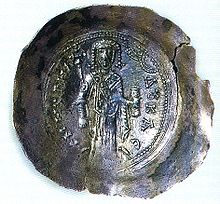- Michael II Komnenos Doukas
-
Michael II Komnenos Doukas Despot of Epirus 
Reign 1230–1266/1268 Died 1266/1268 Predecessor Theodore Successor Nikephoros I Dynasty Komnenos Doukas Father Michael I Mother Unknown Michael II Komnenos Doukas or Comnenus Ducas (Greek: Μιχαήλ Β΄ Κομνηνός Δούκας, Mikhaēl II Komnēnos Doukas), often called Michael Angelos in narrative sources, was the ruler of Epirus from 1230 until his death in 1266/68.
Life
Michael was an illegitimate son of Michael I Komnenos Doukas of Epirus and had gone into exile after his father's murder in 1215. After the defeat and capture of his uncle Theodore Komnenos Doukas by Ivan Asen II of Bulgaria at the Battle of Klokotnitsa he returned to Epirus and became the ruler of the region. It is not entirely clear whether he recognized the supreme authority of his uncle Manuel Komnenos Doukas of Thessalonica or of Ivan Asen II of Bulgaria. Michael II secured the support of local notables by marrying Theodora Petraliphaina, and established a close relationship with the Empire of Nicaea. In 1241 Michael succeeded his uncle Manuel as ruler of Thessaly. In 1238, Michael was visited by the Nicaean Patriarch Germanus II and in 1249 he received the court dignity of despotes from Emperor John III Doukas Vatatzes.
Michael II's relations with Nicaea ensured his neutrality during the conflict in which John III Doukas Vatatzes conquered Thessalonica and penetrated into northern Greece in 1244. However, when he was forced to surrender Dyrrhachium and Servia to the Nicaeans in 1256, Michael determined to expand his state at Nicaea's expense. However, while he was advancing towards Thessalonica, King Manfred of Sicily seized Dyrrhachium and its environs. Resolved to take Thessalonica, Michael came to terms with Manfred and sent him his daughter as wife, ceding the lost towns and the island of Corfu as dowry. He also concluded an alliance with Prince William II Villehardouin of Achaea.
The troops of the three allies overran the Nicaean possessions in Macedonia and in 1259 prepared to fight the Nicaean army led by John Palaiologos, a brother of Emperor Michael VIII Palaiologos, on the plain of Pelagonia. Nevertheless, the allied operation was compromised by mutual suspicion and Michael's illegitimate son John Doukas deserted to the enemy, while Michael himself abandoned his allies. The Nicaeans inflicted a crushing defeat on Prince William of Achaea, who was captured in the battle. While Michael fled to the Ionian Islands, the Nicaeans occupied Epirus but they were faced with so much resistance that they were forced to withdraw. Michael recovered his domains with further help from Manfred. After further warfare another Byzantine victory in 1264 forced him to accept the nominal suzerainty of Michael VIII Palaiologos and to strengthen the bond by dynastic marriages. When Michael II died in or shortly before 1268, his domains were split between his sons Nikephoros I Komnenos Doukas of Epirus and John I Doukas of Thessaly.
Family
By his marriage to Theodora Petraliphaina (St. Theodora of Arta), Michael II had several children, including:
- Nikephoros I Komnenos Doukas, who succeeded as ruler of Epirus
- John Komnenos Doukas
- Demetrios (renamed Michael) Komnenos Doukas
- Helena Angelina Doukaina, who married King Manfred of Sicily
- Anna Komnene Doukaina, who married (1) Prince William II Villehardouin of Achaea and (2) Nicholas II of St Omer, lord of Thebes.
By a mistress, Michael II had at least two other sons:
- John I Doukas, who succeeded as ruler of Thessaly
- Theodore Doukas
References
- The Oxford Dictionary of Byzantium, Oxford University Press, 1991.
- John V.A. Fine Jr., The Late Medieval Balkans, Ann Arbor, 1987.
- D.I. Polemis, The Doukai, London, 1968.
Preceded by
TheodoreRuler of Epirus
1230–1268Succeeded by
Nikephoros IPreceded by
ManuelRuler of Thessaly
1241–1268Succeeded by
John IDespots of Epirus Komnenos-Doukas dynasty Michael I Komnenos Doukas‡ · Theodore Komnenos Doukas‡ · Michael II Komnenos Doukas‡ · Nikephoros I Komnenos Doukas · Thomas I Komnenos DoukasOrsini dynasty Nemanjić dynasty Buondelmonti dynasty Tocco dynasty ‡Also rulers of Thessaly †Also counts palatine of Cephalonia and ZakynthosCategories:- 1268 deaths
- Christians of the Crusades
- Orthodox monarchs
- 13th-century Byzantine people
- Medieval Thessaly
- Despots of Epirus
- Komnenodoukai dynasty
- Illegitimate children of despots of Epirus
Wikimedia Foundation. 2010.
